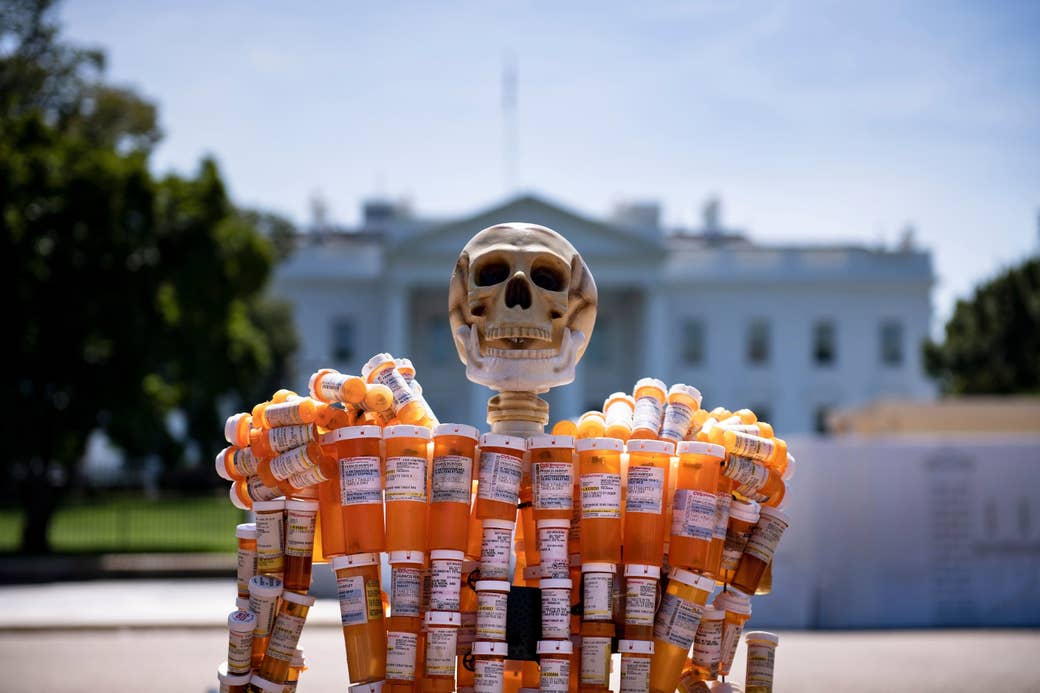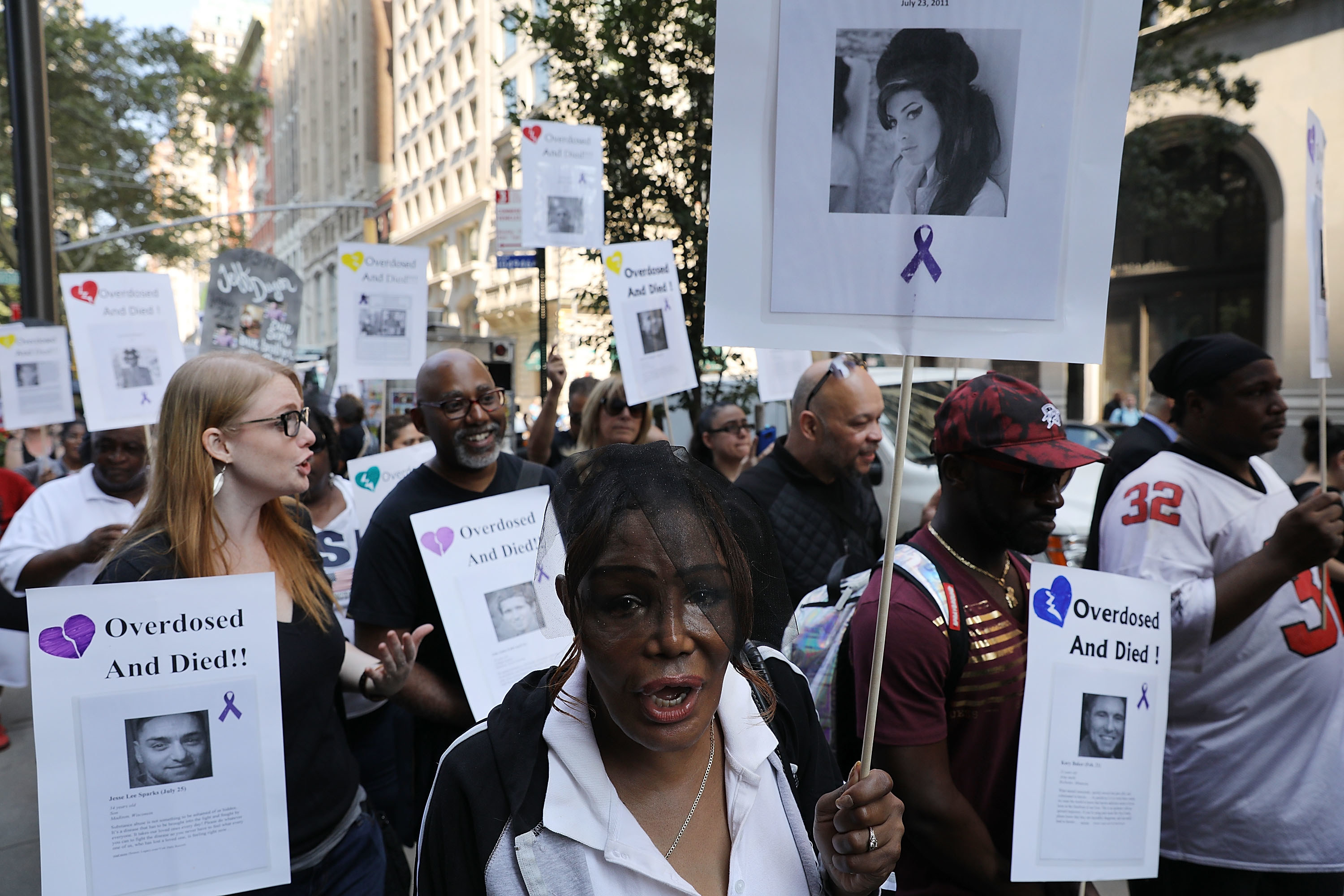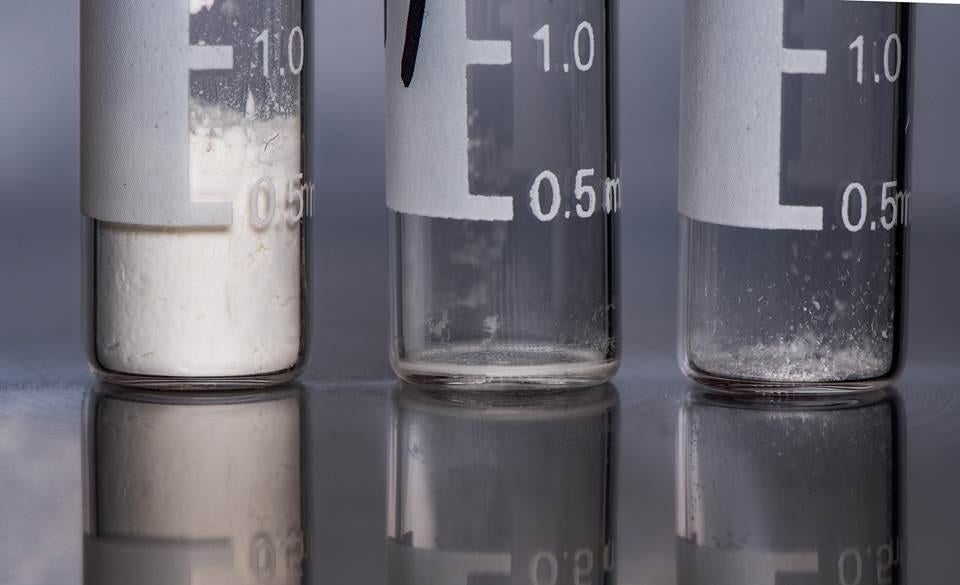
Prince. Tom Petty. Philip Seymour Hoffman. Men and women, young and old, rich and poor. Maybe someone you knew or loved.
All gone, among the 467,000 drug overdose deaths in the US counted so far this decade, with another 67,000 more that will likely be added to that staggering total when this year ends. The epidemic has overtaken both car crashes and gun violence as leading causes of deaths nationwide, and it now causes far more deaths every year than AIDS did at its peak. US drug overdose deaths in this decade exceed the number of battle deaths the country suffered in World War I and World War II combined. And they played a pivotal role in the politics that made Donald Trump president.
The death toll from opioid overdoses over the past 10 years has triggered a national public health emergency and shocked addiction experts. The “war on drugs” rhetoric of the last 50 years finally ended amid all those deaths, which brought the realization that we can’t arrest away the disease of drug addiction, a change that noticeably came with a drug epidemic ravaging white, rural America.
“No one predicted the ferocity of the opioid epidemic,” American Society of Addiction Medicine President Paul Earley told BuzzFeed News.
As the death toll mounted, the epidemic shifted from painkillers to illegal drugs — first to heroin and then to synthetic fentanyl. The drastic shift pushed a relatively new approach called “harm reduction” to center stage, with the aim of limiting overdose deaths by meeting people “where they’re at,” and cutting down the ills of drug use rather than eliminating drug use itself.
The overdose-reversing drug naloxone, once hard to access, is now frequently carried by first responders and available over-the-counter in pharmacies. Needle exchanges, once held up as illegal by Republican and Democratic presidents alike, are now set up in over 300 facilities nationwide and have the approval of President Trump. And cities like Seattle, Philadelphia, and San Francisco are spearheading still-controversial efforts to create “safe injection facilities” for drug users. Billions of dollars in grants are finally flowing to states to integrate more recovery services into health care.
“No one predicted the ferocity of the opioid epidemic,” American Society of Addiction Medicine President Paul Earley told BuzzFeed News.
“Ten years ago people did not recognize substance use disorders as a disease,” said drug policy expert Beth Connolly of the Pew Charitable Trusts, who studies public opinion about drug abuse. “A lot of people really thought of it as a moral failure.”
That shifted after the opioid epidemic. More than 85% of Americans in urban, suburban, or rural counties see drug addiction as a serious problem in their community, according to a 2018 Pew survey.
Even so, the federal money spent on the overdose crisis still amounts to less than the $8.6 billion that the Trump administration requested to build a border wall with Mexico this year. And US overdose death numbers are still unprecedented; the country’s overdose death rate increased by 76% from 2010 to 2017.
“It has been a decade of catching up,” Brendan Saloner of the Johns Hopkins Bloomberg School of Public Health told BuzzFeed News. “We are doing a lot of things better than we did a decade ago. But it is not enough.”

The Painkiller Epidemic
At the start of the 2010s, drug overdose deaths were largely driven by the previous decade’s rampant overprescription of opioid painkillers, such as OxyContin, Vicodin, and Percocet. A wave of recent lawsuits have laid bare how the pharmaceutical industry, led by OxyContin manufacturer Purdue Pharma, knew the drugs were feeding the opioid crisis but still pushed to make doctors and patients alike think they were not addictive.
By 2010, more than 251 million prescriptions for opioid painkillers were being written every year. The Obama administration that year called attention to an uptick in deaths from these drugs, relying on mortality statistics from 2007, in its inaugural national drug control strategy. “Prescription drugs are now involved in more overdose deaths than heroin and cocaine combined,” the report warned. Even then, more than 10,000 people a year were dying of prescription painkiller overdoses in the US.
In response, the government moved to limit how easily people could abuse prescriptions. The FDA approved a form of the opioid painkiller oxycodone that was resistant to being crushed and snorted. And at the center of the burgeoning epidemic, states cracked down on “pill mills,” where doctors rapidly dispensed painkillers, often for cash. At one ring of 40 Florida clinics broken up in 2011, doctors saw up to 100 patients a day and made $1 million a year. That same year, “Operation Pill Nation” saw the arrests of 60 doctors across the Sunshine State.
"We know of no other drug prescribed so frequently that kills so many patients," said Thomas Frieden, former director of the CDC, in 2016, announcing federal guidelines that made opioid painkillers a last option for long-term pain treatment.
While states focused on painkillers as the main culprit behind the tidal wave of deaths, some public health officials started noticing an uptick in young white men checking in for heroin treatment. That became a clear sign of another emerging epidemic: a steady rise in the number of fatal heroin overdoses in the first part of the decade. In 2014, the CDC reported an increase in heroin-related deaths in 28 states, noting a split between older people dying from painkillers and younger ones dying from heroin.
”The heroin supply became more dangerous,” drug policy expert Andrew Kolodny of Brandeis University told BuzzFeed News, with Mexican criminal cartels innovating by delivering the drug to white, rural America. As described in the 2015 book Dreamland: The True Tale of America's Opiate Epidemic by Sam Quinones, the cartels pumped a steady supply of heroin into small cities like Nashville, Cincinnati, Salt Lake City, and Minneapolis, where the drug was previously rare. Suddenly parts of the country that thought they just had a painkiller problem also had a heroin problem.
It is too simple to suggest that all the people with an addiction to painkillers had simply switched to heroin as doctors cracked down on overprescribing, said Earley. An often-cited JAMA Psychiatry study in 2014 noted that, 75% of the time, the new users of hard drugs were introduced to opioids via painkillers. But many people were likely using stolen or illicit pills, not their own prescriptions. “The pills may have come from a grandmother’s medicine cabinet,” said Kolodny.
The end result was that the US had two overlapping overdose epidemics, with heroin and prescription painkillers both killing more than 13,000 people a year by 2015.
“It’s a Chronic Disease”
While officials at the National Institute on Drug Abuse had long argued that addiction should be seen as a chronic “brain disease,” the call took on more urgency by the middle of the decade, when a staggering 52,000 people a year were dying of drug overdoses.
NIDA chief Nora Volkow became the most prominent voice calling for treatment of substance use disorder as “a disease that should be treated like any other.” The move, along with calls to reform drug sentencing laws, would be a striking departure from the “Just Say No” mentality that came to define previous decades. Around the same time, Congress passed two bipartisan bills, which directed more than $1 billion in grants for states to build out their drug treatment networks.
“We had a white epidemic; we changed our tune,” Daniel Ciccarone, a medical epidemiologist with the University of California, San Francisco, told BuzzFeed News. The response to an epidemic among white opioid users in rural states stood in sharp contrast to that of the past decade, which saw blacks 10 times more likely than whites to be imprisoned for drug offenses. “I think a cultural change is coming very slowly, but it is moving,” Ciccarone added.
“We had a white epidemic; we changed our tune.”
As news reports exploded of dubious detox centers defrauding people in recovery and leaving them more likely to die of an overdose, demand increased for more medication-assisted treatment (MAT), which the Substance Abuse and Mental Health Services Administration endorsed as the gold standard for addiction treatment. For opioid use disorder, MAT is the prescription of milder opioids, such as methadone or buprenorphine, to treat addiction — or less often, the opioid-blocking drug naltrexone. From 2014 to 2018, MAT prescription rose 62%, from 2.6 million to 4.2 million people per quarter of the year, according to the IQVIA Institute, which tracks the pharmaceutical industry.
Even conservative bigwigs like Newt Gingrich have come to embrace the need for treatment, previously seen as just replacing one addiction with another in traditional abstinence-focused recovery circles exemplified by Alcoholics Anonymous. The overdose crisis and the attention paid to it by Republican lawmakers might partly explain why in the 2016 election Donald Trump received more votes in counties with the highest mortality rates from drugs, alcohol, and suicide, a factor in winning states like Pennsylvania, Wisconsin, and Michigan.
In 2017, as overdose deaths in the US peaked, killing more than 70,000 people that year, Trump declared the opioid crisis a national public health emergency. The deaths were a leading reason for the decline of US life expectancy over three consecutive years, unheard of during peacetime. This declaration has been renewed eight times since then.
All the attention from public health officials, Congress, and the White House had perhaps started to make a difference by last year, when overdose deaths began to level off nationwide to a still-horrific 68,000 victims. The Bipartisan Policy Center estimates federal agencies had spent $7.4 billion on combating the opioid crisis in 2018, nearly double the previous year's total.
The Affordable Care Act kicking in has also made a big difference in getting more people into recovery, because under the law, addiction is no longer considered a pre-existing condition for insurance purposes. More states, like Ohio and West Virginia, accepted Medicaid expansion under Obamacare and increased the number of people receiving MAT, by around 70% in such states. The number of states putting time limits on addiction treatment length went down by more than 50%.
Police and fire departments far more frequently equip officers with naloxone, an opioid overdose-reversing drug. In 2012, President Obama ended a ban on needle exchanges, which cut rates of infectious diseases among drug users. Now those sites are supported by the Trump administration, and even conservative states like Kentucky now have 54 active sites, albeit with more needed.
“There has been real progress, real change,” Regina LaBelle, a former official with the White House Office of National Drug Control Policy, told BuzzFeed News.

Game Changer
At mid-decade, as the medical establishment scrambled to address the new heroin epidemic, something even worse happened — fentanyl. An opioid 30 to 50 times more potent than heroin — with analogs such as carfentanil that are hundreds of times stronger than fentanyl itself — entered the illicit drug supply.
“Fentanyl was a game changer,” Kolodny said. In March 2015, the Drug Enforcement Administration released a nationwide alert about fentanyl, warning that the drug was widespread and “extremely dangerous.” Ohio, for example, reported 502 deaths tied to fentanyl in 2014, a 500% increase from the year before, and the state soon became infamous for its soaring rates of overdose deaths.
In March 2017, at the height of the state's fentanyl epidemic, the coroner in Canton, Ohio, ran out of storage space for dead bodies. Ohio police data shows that heroin seizures containing fentanyl or carfentanil increased from 3.4% in 2014 to 48.6% in 2017, a year that saw an astonishing 4,700 people in the state die from a drug overdose.
Not only was the increased potency of fentanyl dangerous, but the variability it introduced into the heroin market proved deadly, both because various analogs came in bewildering strengths, and because the difference between a safe dose and a fatal one was now only a milligram or less. “Drug dealers are not chemists,” said American Society of Addiction Medicine President Paul Earley. “There’s no quality control in illegal drugs.”
By 2017, fentanyl and its analogs had quickly emerged as the leading cause of drug overdose deaths nationwide, killing more than 28,000 people, almost as much as heroin and painkillers combined. Fentanyl deaths were concentrated in the Midwest, Appalachia, and the Northeast, where brown powder heroin was diluted with illicit fentanyl imported from China into Mexico and distributed by organized crime networks.
The Fourth Wave
Even as drug overdose deaths have started to level off, and attitudes toward drug addiction have begun to change, another shift has started that will likely extend into the next decade. Deaths from stimulant drugs, notably cocaine and meth, have suddenly started increasing.
Drug users may be shifting back to those drugs in reaction to the opioid deaths, suggested Ciccarone, a familiar swing of the pendulum between depressants and stimulants seen in past drug epidemics.
“I’m calling it a fourth wave in the epidemic. Meth is not supposed to be a deadly drug. Now we have young people dying from it.”
More of the deaths are among older heroin users, often longtime black or Latino users in cities, who favor “speedballs,” mixtures of cocaine and heroin, reports the Chicago Urban League. As well, Ciccarone and other epidemiologists are seeing more mixed stimulant and opioid use, or “goofballs,” among younger drug users, everywhere from Washington state to West Virginia.
“I’m calling it a fourth wave in the epidemic,” said Ciccarone. “Meth is not supposed to be a deadly drug. Now we have young people dying from it.”
The challenge posed by these puzzling new deaths is to build a drug treatment system that covers more than opioid addiction, said many of the experts interviewed by BuzzFeed News. The Trump administration has focused heavily on the opioid crisis: Trump himself donated his most recent $100,000 quarterly salary to "continue the ongoing fight against the opioid crisis," and the administration announced another $1.8 billion in state grants in September. But this focus on opioids alone might miss the next phase of the epidemic.
“We don’t know what drug will be the next heroin, but there will be one,” said Ciccarone. ●
